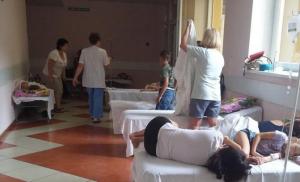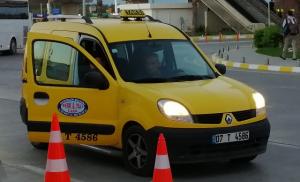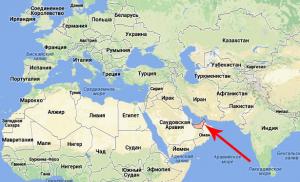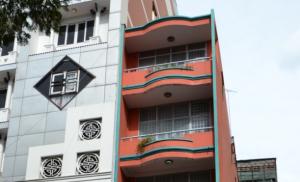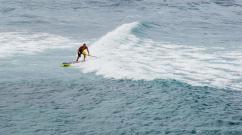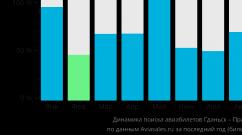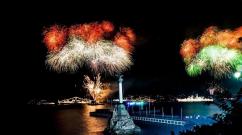Presentation on the topic of the current state of cubes. Cuba: presentation of the country, video and description of geographical location





Flora Thanks to the even climate and fertile soils, more than 3,000 species of tropical fruit plants and flowers grow in Cuba. On moist red and red-brown soils of plains and low slopes they grow tropical forests of numerous deciduous and evergreen species, including the royal palm and the cana palm.


Flora In some of the wetter mountain areas there are forests of mahogany, guaiac wood, logwood and cedrola. Some areas are occupied by vegetation similar to grass savannas. For districts southeast coast and some others are characterized by prickly small-leaved shrubs with an admixture of cacti and agaves.

Flora The official flower of Cuba is the mariposa, a flower of the ginger family, symbolizing purity, rebellion and independence. It is found in the wet river deltas and numerous lagoons of the island, as well as in the gardens of every self-respecting Cuban.

Animal world Fauna The fauna of Cuba due to its island position is quite poor. In addition, it has suffered greatly as a result of human economic activity. There are no predatory animals or poisonous snakes in Cuba, there are many bats, a very rich species composition of birds, insects and terrestrial mollusks, a diverse species composition of fish, sea turtles, a lot of shrimp and lobsters.

Fauna The fauna of Cuba, the largest of the West Indies islands, is distinguished by a small number of vertebrates and a significant number of endemics. Twenty species of birds living there are found nowhere else, including the world's smallest bird, the bee hummingbird, weighing just 2 grams.

Fauna The national bird of Cuba is the Cuban trogon. The Strogon order includes brightly colored birds that fit well into tropical forests with their exotic beauty. The bright red, white and blue plumage of the Cuban Tarragona matches the colors of the national flag. When deprived of its freedom, a Trogon is believed to die of a broken heart.

Fauna In the east of Cuba, several populations of one of the rare species mammals insectivorous Cuban slittooth. This species was until recently considered extinct and was included in the register of extinct species. In appearance it resembles a badger, but differs in its long nose, characteristic of insectivores.

Population People of mixed origin. By the time the Spaniards arrived here, Cuba was inhabited by tribes of Sibones, Arawak Indians, Guanahanabees and Indians who migrated from Haiti. But as a result of Spanish colonization, the Indians were mostly exterminated. Language – Spanish

History Cuba was inhabited by Indian tribes until the end of the 16th century. The Guanahatabey people moved to the island from the mainland presumably in the 6th millennium BC. In 1511, Diego Velazquez de Cuellar founded the first settlement in Cuba, Asuncion. Cuba was under Spanish rule until 1898, when it came under US control as a result of the Spanish-American War. The American occupation of the island officially ended on January 1, 1902, when Cuba's first elected president, Tomas Estrada Palma, took office. In 1933, as a result of a military coup, Fulgencio Batista came to power, remaining head of state until 1959, when he was overthrown as a result of the revolution. A generation of politicians led by Fidel Castro came to power, and since 1961 they declared the country's socialist orientation. Currently, Cuba remains one of several states that continue to declare their socialist orientation. Diego Velazquez de Cuellar Fulgencio Batista





Holidays January 1-2 - Liberation Day (victory of the Cuban revolution in 1959). May 1 - International Workers' Day, Labor Day. July 26 is National Uprising Day (attack on the Moncada barracks in Santiago de Cuba; July 25 and 27 are also holidays). October 10 - Anniversary of the beginning of the wars for independence from Spanish rule, Cuban Culture Day. December 25 - Christmas. Festivals Guitar Karosas

Cuisine of Cuba Gastronomic delights are largely borrowed from the indigenous population or colonialists. Different regions have their own unique recipes. Cuban cuisine is based on seafood, which the population does not need. Various meats, vegetables and fruits are eaten. The unique geography of Cuba is also reflected in the national dishes. One of the most popular dishes is ajiaco, which is prepared from meat and vegetables. Roasted pork lechon is also very common in the island nation. Meat is most often served with a sauce with a lot of tomatoes and garlic. Rum, beer, cocktails and lemonade for every taste are sold in all cafes and beach bars.

Minerals Cuba occupies one of the leading places in the world in nickel mining (2nd place in the world in reserves and 3rd in production), has significant reserves of chromium, manganese, iron and copper ores, asbestos, rock salt, and phosphorites. Oil and gas fields have been discovered in the west of the country. Transport On the island of Cuba there is railway(Cuban Railway), network highways. Sea and air communications have been established with other countries. Cuba's leading airline, Cubana de Aviaci?n, has offices in 32 countries.

References: 1) Cuba - Wikipedia 2) Cuba travel agency 3) colina.html Cuba Hotel colina.html 4) c47-Cuba.html Attractions of Cuba c47-Cuba.html


Information for the presentation of Cuba
Cuba is known throughout the world under another romantic name, “Liberty Island,” although this unofficial name is island state has been used only since 1959, when the revolution led by Fidel Castro won on the island. Today Cuba is a developed socialist state with a population of about 12 million people.
Cuba is located on the island of the same name and many other small islands that are part of the Greater Islands. Antilles. Most of the country is the island of Cuba, with an area of approximately 105 thousand square kilometers. The other islands of the Cuban state make up less than 5% of its territory. It should be noted that as a result of the conflict between Spain and the United States, the Americans received the right to own a small piece of land at Guantanamo, where the world-famous military base. Cuba is washed on all sides by the Caribbean Sea, and its beaches, located almost along the entire coast of the country, are the best in the world.
All beaches on the Cuban coast are free and owned by the local municipality. Only a few hotels have small sections of the coast assigned to them, where local residents are not allowed.
Cuba has an amazingly warm and mild climate thanks to its geographical location. Cuba is separated from the American state of Florida only by the small Florida Strait, which is 153 km wide. A warm current passes on the surface of the strait, which is part of the Gulf Stream. Warm sea currents, passing along the shores of the island, even in winter time ensure the water temperature on Cuban beaches is at least 22 C, and in the summer this figure is 27-29 C. The Cuban climate as a whole is tropical trade wind, which leads to a clear division into 2 seasons: dry and rainy. Rain occurs in Cuba during the period from May to October, dry, sunny weather reigns here from November to April.
Weather in Cuba
Cuba is separated from the Yucatan Peninsula, which is Mexican territory, by a short distance by sea. The island of Cuba is also surrounded heavenly places, including Jamaica, Bahamas And Dominican Republic. Cuba is separated from these places by small straits with a width of 70-160 km.
In clear weather, you can see Florida from the coast of Cuba located in the north, because the distance to it is no more than 150 km. The proximity of America haunts illegal immigrants crossing the strait in their homemade boats.
The flight time to Liberty Island is approximately 12 hours. Direct flights from Russia are operated by Aeroflot and Transaero airlines, whose planes land in Havana and northern Varadero resort town Cuba, whose beaches are the best in this part of the world, as recognized by UNESCO. Regular flights to Cuba are made only from two Russian cities, St. Petersburg and Moscow. Many charter flights also depart from capital airports, which is why travelers should take care in advance to find convenient connecting flights.
History of Cuba. The settlement of Cuba began in the fourth millennium BC. Apparently, the first inhabitants of the island moved there from South and Central America. The Indians knew agriculture, grew corn and other food crops, hunted birds, rodents, and caught turtles and fish. By the time of the Spanish conquest of Cuba at the beginning of the 16th century, the bulk of the Indians lived in conditions of the decomposition of the primitive communal system. On October 28, 1492, Columbus's first expedition set off in search of rich overseas lands and marked the beginning of the era of the Great geographical discoveries, reached North east coast Cubes. On the same day, he wrote in his diary that the eyes of man had never seen a more beautiful island than this. In 1510, the Spanish colonization of Cuba began. By 1514, the Spaniards had founded seven cities from the first capital of Baracoa in the far east to Havana. Later, all of them, except Baracoa, changed their location. The colonization of the island was accompanied by the almost complete destruction of the Indians. They offered heroic resistance to the Spaniards under the leadership of their leaders - Atuey and Guama.
Slide 1
 Slide 2
Slide 2
 Slide 3
Slide 3
 Slide 4
Slide 4
 Slide 5
Slide 5
 Slide 6
Slide 6
 Slide 7
Slide 7
 Slide 8
Slide 8
 Slide 9
Slide 9
 Slide 10
Slide 10
 Slide 11
Slide 11
 Slide 12
Slide 12
 Slide 13
Slide 13
 Slide 14
Slide 14
 Slide 15
Slide 15
 Slide 16
Slide 16
 Slide 17
Slide 17
 Slide 18
Slide 18
 Slide 19
Slide 19
 Slide 20
Slide 20
 Slide 21
Slide 21
 Slide 22
Slide 22
 Slide 23
Slide 23
 Slide 24
Slide 24
 Slide 25
Slide 25
The presentation on the topic "cube" can be downloaded absolutely free on our website. Project subject: Geography. Colorful slides and illustrations will help you engage your classmates or audience. To view the content, use the player, or if you want to download the report, click on the corresponding text under the player. The presentation contains 25 slide(s).
Presentation slides

Slide 1
Completed by: Anton Prudanov Teacher: Yakovlev M.Yu.

Slide 2
The area of the Republic of Cuba is 111,000 square meters. km., including the island of Cuba - the largest in the West Indies and which gave its name to the entire country.
In the south, Cuba is washed by waters Caribbean Sea. The Bahamas border Cuba to the northeast, Haiti, Jamaica and the Cayman Islands to the south, the Yucatan Strait to the west separates it from Mexico, and the Strait of Florida to the north from the United States of America. The island of Cuba stretches along the equator for 1200 km, its width ranges from 30 to 190 km. An important element of the coast are coral reefs, atolls and numerous small islands. The length of Cuban reefs ranks third in the world.

Slide 3
The surface of Cuba is characterized by lowlands located on limestone deposits of the Tertiary period. In the southwestern part of Cuba, the relief changes: it stretches along the coast mountain range Sierra Maestra, consisting of masses of volcanic origin.
Here is the most high point islands - Turkino Peak (1974 m above sea level). In the area of the Zapata Peninsula there are extensive swampy lowlands. An important element of the coast are coral reefs, atolls and numerous small islands. The length of Cuban reefs ranks third in the world. The island of Cuba is dominated by picturesque limestone lowlands, and only small areas in the southwest, northwest and central part of the island are occupied by mountain ranges.

Slide 4
Political structure
The highest body of state power of the Republic of Cuba is the National Assembly of People's Power, elected for five years, endowed with legislative rights. The National Assembly elects the Council of State from among its deputies. The highest executive body is the Council of Ministers. The Chairman of the State Council and the Council of Ministers is the head of state. Administratively, Cuba is divided into 14 provinces, which in turn are divided into 169 municipalities, one of which, Juventud, is centrally subordinate. A popular slogan in Cuba is: “The power of the people is really power!” " The highest governing force of Cuban society and state is the Communist Party of Cuba.

Slide 5
The triangle is a symbol of freedom, equality and fraternity, and the three blue stripes represent the three parts into which the Spaniards divided Cuba. The white color symbolizes the purity of the revolutionaries' aspirations and justice, the red color symbolizes the blood shed in the struggle for independence.

Slide 6
The national coat of arms represents the island. It is designed like a leather shield and is divided into three sections. In its horizontal upper part there is a golden key between two mountains, the sun rising over the sea - which represents in symbolic form the position of Cuba in the Gulf - Cuba is the key to the Gulf of Mexico, between the two Americas. The blue and white stripes at the bottom left represent the state's island position during the colonial period. Right side, Cuban landscape, royal palm - a symbol of the unbending character of the Cuban people.

Slide 7
Minerals
According to its tectonic structure, Cuba is included in the Antilles-Caribbean region of the Cordillera fold belt. At the same time, it combines the folded structures of the island arcs of the Antilles and subplatform areas. Particularly characteristic of Cuba is the wide distribution of young limestones. Currently, Cuba is in a zone of high seismicity (up to 7 points). The now highly depleted copper deposits are associated with the folded structures. There are also manganese ores, and bauxite deposits are also possible. But the main mineral wealth of Cuba of world importance is its reserves of nickel ores combined with cobalt. Cuba is well endowed with raw materials for the building materials industry. Some coastal areas have signs of oil content. The almost complete absence of fuel and energy resources creates great difficulties for economic development.

Slide 8
Economy of Cuba. Positive aspects.
The main sector of the Cuban economy is the sugar industry. There are about 170 sugar processing factories in the country. There are enterprises of ferrous and non-ferrous metallurgy, mechanical engineering, chemical industry, and two oil refineries. Light and food industries are developed. The famous Cuban cigars are produced by 6 tobacco factories. An important source of income is international tourism. The share of the mining industry in GDP is 3%. Cuba ranks fifth in the world in terms of nickel ore reserves. Cobalt ore accounts for 26% of the world's reserves.

Slide 9
Economy of Cuba. Negative aspects.
Due to the US embargo, there is no access to important markets and investments. Acute shortage of foreign currency. Fluctuations in world prices for sugar and nickel. Complicated trade restrictions and lack of legal regulations hinder investment. Poor infrastructure. Shortage of fuel, fertilizers and spare parts.

Slide 10
The climatic conditions and resources of Cuba are determined, first of all, by the location of the territory directly south of the tropics, among the Atlantic Ocean, as well as by the passage of warm currents near the island that form the Gulf Stream. Cuba has enormous thermal resources of solar heat. Average monthly temperatures on the plains are always high: in January 22.5°, in August 27.8°. But the fluctuations in extreme temperatures are quite significant. The average maximum temperature on the plains exceeds 30°C.

Slide 11
Humidity
Relatively high annual precipitation is 1380mm. The year is divided not into 4 seasons, but into 2 seasons - dry, rainy. The rainy season usually lasts from May to October. The dry season usually begins in November and ends in April. This is the period of greatest economic activity, as it is the season for cutting and processing sugar cane. High humidity is typical for the climatic conditions of all regions of the country. Average relative air humidity is 79%. In combination with constant high temperatures, very high air humidity has a generally unfavorable effect. Humidity oppresses a person. The climate of Cuba requires special treatment (tropicalization) of all industrial products and structures. In general climatic conditions Cuba is much more favorable than most other, especially continental tropical countries.

Slide 12
Animal world
Due to its island position, the fauna of Cuba is quite poor. In addition, it has suffered greatly as a result of human economic activity. There are no predatory animals or poisonous snakes in Cuba, there are many bats, a very rich species composition of birds, insects and terrestrial mollusks, a diverse species composition of fish, sea turtles, a lot of shrimp and lobsters.

Slide 13
Tobacco production
Since the 17th century, the production of first-class tobacco has become an important specialization of Cuba. Cuban cigars are famous all over the world.

Slide 14
Main religion: Catholicism, various African religions are common. Holidays January 1-2 - Liberation Day (victory of the Cuban revolution in 1959). May 1 - International Workers' Day, Labor Day. July 26 is National Uprising Day (attack on the Moncada barracks in Santiago de Cuba; July 25 and 27 are also public holidays). October 10 - Anniversary of the beginning of the wars for independence from Spanish rule, Cuban Culture Day. December 25 - Christmas.

Slide 15
History of Cuba
The settlement of Cuba began in the fourth millennium BC. Apparently, the first inhabitants of the island moved there from South and Central America. The Indians knew agriculture, grew corn and other food crops, hunted birds, rodents, and caught turtles and fish. By the time of the Spanish conquest of Cuba at the beginning of the 16th century, the bulk of the Indians lived in conditions of the decomposition of the primitive communal system. On October 28, 1492, Columbus's first expedition, which set off in search of rich overseas lands and marked the beginning of the Age of Discovery, reached the northeastern coast of Cuba. On the same day, he wrote in his diary that the eyes of man had never seen a more beautiful island than this. In 1510, the Spanish colonization of Cuba began. By 1514, the Spaniards had founded seven cities from the first capital of Baracoa in the far east to Havana. Later, all of them, except Baracoa, changed their location. The colonization of the island was accompanied by the almost complete destruction of the Indians. They offered heroic resistance to the Spaniards under the leadership of their leaders - Atuey and Guama.

Slide 16
Suppressed revolution
In the life of each country there are several names and dates with which the most glorious pages of history are associated. One of these milestones in Cuban history is October 10, 1868, when the patriot Carlos Manuel De Cespedes raised all his compatriots to revolt against the rule of Spain. For ten years, from 1868 to 1878, Cuban rebels fought the Spanish under the slogan “Independence or Death!” On April 10, 1869, the first Constitution of Cuba was adopted. She proclaimed the freedom of black slaves. Many thousands of blacks became rebels. But Cuba could not win. Among the reasons for the defeat were the inconsistency of leaders, the heterogeneity of the rebels and the disunity of different regions of the country. In addition, the Spaniards had approximately 20 times more troops than the rebels.

Slide 17
End of Spanish rule
Cuban patriots did not stop fighting for independence. The ideologist, organizer and inspirer of this struggle was José Martí. In 1892, he created the first revolutionary party. In April 1895, Jose Martí's troops landed in Cuba and launched active military operations. On May 19, Jose died in a battle with the Spaniards. But the struggle continued, covering more and more areas of the country. On September 16, 1895, the rebels proclaimed the creation Cuban Republic and its separation from Spain. The war of 1895-1898 was a difficult test for the Cuban people.

Slide 18
As a result of the coup d'etat on March 10, 1952, Fulgencio Batista came to power in Cuba and established a military-police dictatorship in the country. The coup caused discontent among progressive-minded youth, the most radical group of which was led by a young lawyer and aspiring politician Fidel Castro Ruz. On July 26, 1953, a group of rebels, counting on the support of the broad masses, led by Fidel Castro, stormed the fortified Moncada barracks in Santiago de Cuba. After a two-hour battle, the rebel detachment was defeated, many revolutionaries were killed, and the rest were put on trial. Although all the defendants received long terms imprisonment (Fidel Castro was sentenced to 15 years), under public pressure, Batista was soon forced to grant amnesty to the rebels.

Slide 19
The Castro brothers emigrated to Mexico, where they did not abandon their plans to overthrow the Batista dictatorship and began to create an organization for future revolutionary action, known as M-26. In Mexico, by that time there had been a meeting between Castro and Ernesto Guevara, who joined the ranks of M-26. Flag of the 26 July Movement

Slide 20
The first steps of the revolution
During the first three months The position of the revolutionaries remained critical, but they managed to win the trust of the inhabitants of the region and organize significant military pressure on local military garrisons. In addition to conducting combat operations in rural areas, the M-26 with the help of sympathetic elements in the student community and armed forces organized several performances in cities, which, however, were of little importance. The rebels were greatly helped by the fact that the Batista government during this period of time was in strained relations with Cuba's main economic partner and military supplier of that time, the United States.

Slide 21
In the summer of 1958, the strategic initiative passed to the side of the revolutionaries. By the fall, the provinces of Oriente and Las Villas were almost entirely under the control of the rebels. On January 1, 1959, rebel troops entered Santiago, while in the west, rebels led by Che Guevara captured the city of Santa Clara. Although the situation did not yet seem catastrophic for the regime, on the same day Batista left the island, after which the administration he left virtually ceased to exist. On January 2, rebel troops entered Havana, and on January 6, Fidel Castro solemnly arrived in the capital.

Slide 22
The Cuban Revolution, already at its initial stage, completely restored national sovereignty, destroyed the bourgeois state apparatus, eliminated the omnipotence of the US monopolies and the regime of exploitation of the working people of town and countryside. In 1959 - 1960, Cuba carried out the nationalization of industry, transport, banks, trade, as well as measures were taken to eliminate unemployment, transfer housing to workers and improve their working and living conditions.

Slide 23
Cuba has achieved enormous, universally recognized successes in the social field. In December 1875, the first congress took place in Havana Communist Party Cubes. On February 24, 1976, the constitution of socialist Cuba came into force. In 1978, the 11th World Festival of Youth and Students was held in Cuba; in 1980, the first Cuban astronaut flew into space. US plans to isolate Cuba have failed. Cuba maintains diplomatic relations with more than 100 countries.

Tips for making a good presentation or project report
- Try to involve the audience in the story, set up interaction with the audience using leading questions, a game part, do not be afraid to joke and smile sincerely (where appropriate).
- Try to explain the slide in your own words, add additional interesting facts, you don’t need to just read the information from the slides, the audience can read it themselves.
- There is no need to overload the slides of your project with text blocks; more illustrations and a minimum of text will better convey information and attract attention. The slide should contain only key information; the rest is best told to the audience orally.
- The text must be well readable, otherwise the audience will not be able to see the information being presented, will be greatly distracted from the story, trying to at least make out something, or will completely lose all interest. To do this, you need to choose the right font, taking into account where and how the presentation will be broadcast, and also choose the right combination of background and text.
- It is important to rehearse your report, think about how you will greet the audience, what you will say first, and how you will end the presentation. Everything comes with experience.
- Choose the right outfit, because... The speaker's clothing also plays a big role in the perception of his speech.
- Try to speak confidently, smoothly and coherently.
- Try to enjoy the performance, then you will be more at ease and less nervous.
Download:
Preview:
1 slide:
The largest of the islands in the Caribbean region, the Republic of Cuba occupies the island of the same name off the coast of the continent. Cuban poets compare their island to a green lizard lying on the blue ocean.
Slide 2:
The Triangle Flag is a symbol of freedom, equality and fraternity, and the three blue stripes represent the three parts into which the Spaniards divided Cuba. The white color symbolizes the purity of the revolutionaries' aspirations and justice, the red color symbolizes the blood shed in the struggle for independence.
Coat of Arms - The national coat of arms represents the island. It is designed like a leather shield and is divided into three sections. In its horizontal upper part there is a golden key between two mountains, the sun rising over the sea - which represents in symbolic form the position of Cuba in the Gulf - Cuba is the key to the Gulf of Mexico, between the two Americas. The blue and white stripes at the bottom left represent the state's island position during the colonial period. Right side, Cuban landscape, royal palm - a symbol of the unbending character of the Cuban people.
Slide 3:
In the south, Cuba is washed by the waters of the Caribbean Sea. The Bahamas border Cuba to the northeast, Haiti, Jamaica and the Cayman Islands to the south, the Yucatan Strait to the west separates it from Mexico, and the Strait of Florida to the north from the United States of America. The island of Cuba stretches along the equator for 1200 km, its width ranges from 30 to 190 km. An important element of the coast are coral reefs, atolls and numerous small islands. The length of Cuban reefs ranks third in the world.
Slide 4:
Climate
The climatic conditions and resources of Cuba are determined, first of all, by the location of the territory directly south of the tropics, among the Atlantic Ocean, as well as by the passage of warm currents near the island that form the Gulf Stream. Cuba has enormous thermal resources of solar heat. Average monthly temperatures on the plains are always high: in January 22.5, in August 27.8. But the fluctuations in extreme temperatures are quite significant. The average maximum temperature on the plains exceeds 30.
Slide 5:
Tectonic structure and minerals
According to its tectonic structure, Cuba is included in the Antilles-Caribbean region of the Cordillera fold belt. At the same time, it combines the folded structures of the Antilles island arcs and subplatform areas. Particularly characteristic of Cuba is the wide distribution of young limestones. Currently, Cuba is in a zone of high seismicity (up to 7 points). The now highly depleted copper deposits are associated with the folded structures. There are also manganese ores, and bauxite deposits are also possible. But the main mineral wealth of Cuba of world importance is its reserves of nickel ores combined with cobalt. Cuba is well endowed with raw materials for the building materials industry. Some coastal areas show signs of oil potential. The almost complete absence of fuel and energy resources creates great difficulties for economic development.
Slide 6:
Animal world
Due to its island position, the fauna of Cuba is quite poor. In addition, it has suffered greatly as a result of human economic activity. There are no predatory animals or poisonous snakes in Cuba, there are many bats, a very rich species composition of birds, insects and terrestrial mollusks, a diverse species composition of fish, sea turtles, a lot of shrimp and lobsters.
Slide 7: everything on the slide
Slide 8: negative aspects on the slide
Slide 9: everything is clear too, it’s on the slide
Slide 10:
Holidays
New Year-b The majority of the population of Cuba professes Catholicism, but Catholic Christmas in December is not celebrated here as brightly as, for example, in Europe. This is due to strict prohibitions associated with the republic’s communist past. Celebrating Christmas as a religious holiday was prohibited here until 1998.
But the New Year is celebrated here cheerfully - after New Year's dinner with family, Cubans and guests of Liberty Island go out to squares or beaches and party until the morning - fortunately, the hot climate contributes to this much more than ours. IN New Year's Eve you can go to a disco, a concert, stroll along the streets of big cities (where new year holidays celebrated most vividly) or celebrate the holiday on the beach, admiring the stars.
Havana Carnival– held on weekends from July 15 to August 15.
The main events of the Havana Carnival take place on the capital's Malecon embankment. There, participants dressed in enchanting costumes have fun, drink and dance from morning to night. Huge platforms move along the main street of the city, on which different carnival teams from all over Cuba compete in brightness and rhythm. Carnival participants prepare costumes, dances and shows almost all year to become the best at this carnival procession.
The highlight of the Havana Carnival is the procession of giant figures that represent Cuban political figures. Music sounds from everywhere, fireworks and fireworks explode. So if you want to take part in this unique holiday of soul and heart, then go to Cuba from July to August.
Carnival in Santiago de Cuba
At the end of July, another carnival takes place - not in Havana, but in Santiago de Cuba. During the carnival, festive processions take place through the streets of the city, fireworks sound and music plays, and hot Cuban guys and girls dance so infectiously that all tourists are instantly drawn into this celebration of life. And strong exotic cocktails give them inspiration to dance until the morning.
Preview:
To use presentation previews, create a Google account and log in to it: https://accounts.google.com
Slide captions:
FLAG The triangle is a symbol of freedom, equality and fraternity, and the three blue stripes represent the three parts into which the Spaniards divided Cuba. COAT OF ARMS The national coat of arms represents the island. It is designed like a leather shield and is divided into three sections.
CLIMATE Cuba has enormous thermal resources of solar heat. Average monthly temperatures on the plains are always high: in January 22.5°, in August 27.8°. But the fluctuations in extreme temperatures are quite significant. The average maximum temperature on the plains exceeds 30.
According to its tectonic structure, Cuba is included in the Antilles-Caribbean region of the Cordillera fold belt. Cuba is well endowed with raw materials for the building materials industry. But the main mineral wealth of Cuba of world importance is its reserves of nickel ores combined with cobalt. Some coastal areas show signs of oil potential. The almost complete absence of fuel and energy resources creates great difficulties for economic development. Tectonic structure and minerals
WILDLIFE The fauna of Cuba due to its island position is quite poor. There are no predatory animals or poisonous snakes in Cuba, there are many bats, a very rich species composition of birds, insects and terrestrial mollusks, a diverse species composition of fish, sea turtles, a lot of shrimp and lobsters.
The famous Cuban cigars are produced by 6 tobacco factories An important source of income is international tourism In terms of nickel ore reserves, Cuba ranks 5th in the world Medicine at the highest level with low cost of services Cobalt ore accounts for 26% of world reserves The main branch of the economy is the sugar industry (approx. 170 sugar refineries) STRENGTHS
Economy of Cuba. Negative aspects. Due to the US embargo, there is no access to important markets and investments. Acute shortage of foreign currency. Fluctuations in world prices for sugar and nickel. Complicated trade restrictions and lack of legal regulations hinder investment. Poor infrastructure. Shortage of fuel, fertilizers and spare parts.
Main religion: Catholicism, various African religions are common. The majority of those living in the country are Cubans. In addition to them, on the island you can easily meet “neighbors” from Haiti, the Chinese, Jews, Americans, Japanese and Europeans.

